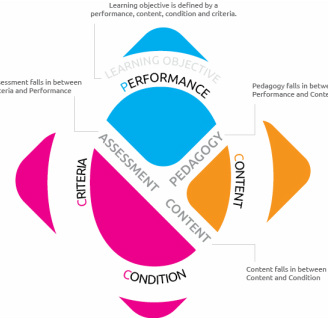Many of the leaders in faculty development programs have identified facilitation by experts as a key ingredient in increasing the effectiveness of instructional development programs (Felder et al., 2011). For the IMOD system, which will provide professional development with the use of an online tool, expert facilitation is embedded within its design, through the application of a framework that is informed by research in the area of instructional development for STEM disciplines. This framework translates the scholarship into a software platform that supports the development of a rich, meaningful knowledge structure that can be queried to:
- Identify omissions in a course design
- Identify inconsistencies in the relationships between the elements of the course being designed
- Identify relevant strategies for instruction and/or assessments
- Provide just-in-time guidance to the user on the design process.
IMOD FRAMEWORK
The IMODframework adheres strongly to the OBE approach and treats the course objective as the spine of the structure. New constructs (not included in the models previously discussed) are incorporated to add further definition to the objective. The work of Robert Mager (1984, 1997) informs the IMOD definition of the objective. Mager identifies three defining characteristics of a learning objective: Performance – description of what the learner is expected to be able to do; Conditions – description of the conditions under which the performance is expected to occur; and the Criterion – a description of the level of competence that must be reached or surpassed. For use in the IMOD framework an additional characteristic was included, i.e., the Content – description of the disciplinary knowledge, skill, or behavior to be attained. The resulting IMOD definition of the objective is referred to as the PC3 model.
The other course design elements (i.e., Content, Pedagogy, and Assessment) are incorporated into the IMOD framework through interactions with two of the PC3 characteristics. Course-Content is linked to the content and condition components of the objective. The condition component is often stated in terms of pre-cursor disciplinary knowledge, skills or behaviors. This information, together with the content defined in the objective, can be used to generate or validate the list of course topics. Course-Pedagogy is linked to the performance and content components of the objective. The types of instructional approaches or learning activities used in a course should correspond to the level of learning expected and the disciplinary knowledge, skills or behaviors to be learned. The content and performance can be used to validate pedagogical choices. Course-Assessment is linked to the performance and criteria components of the objective. This affiliation can be used to test the suitability of the assessment strategies since an effective assessment, at the very least, must be able to determine whether the learner’s performance constitutes competency.




